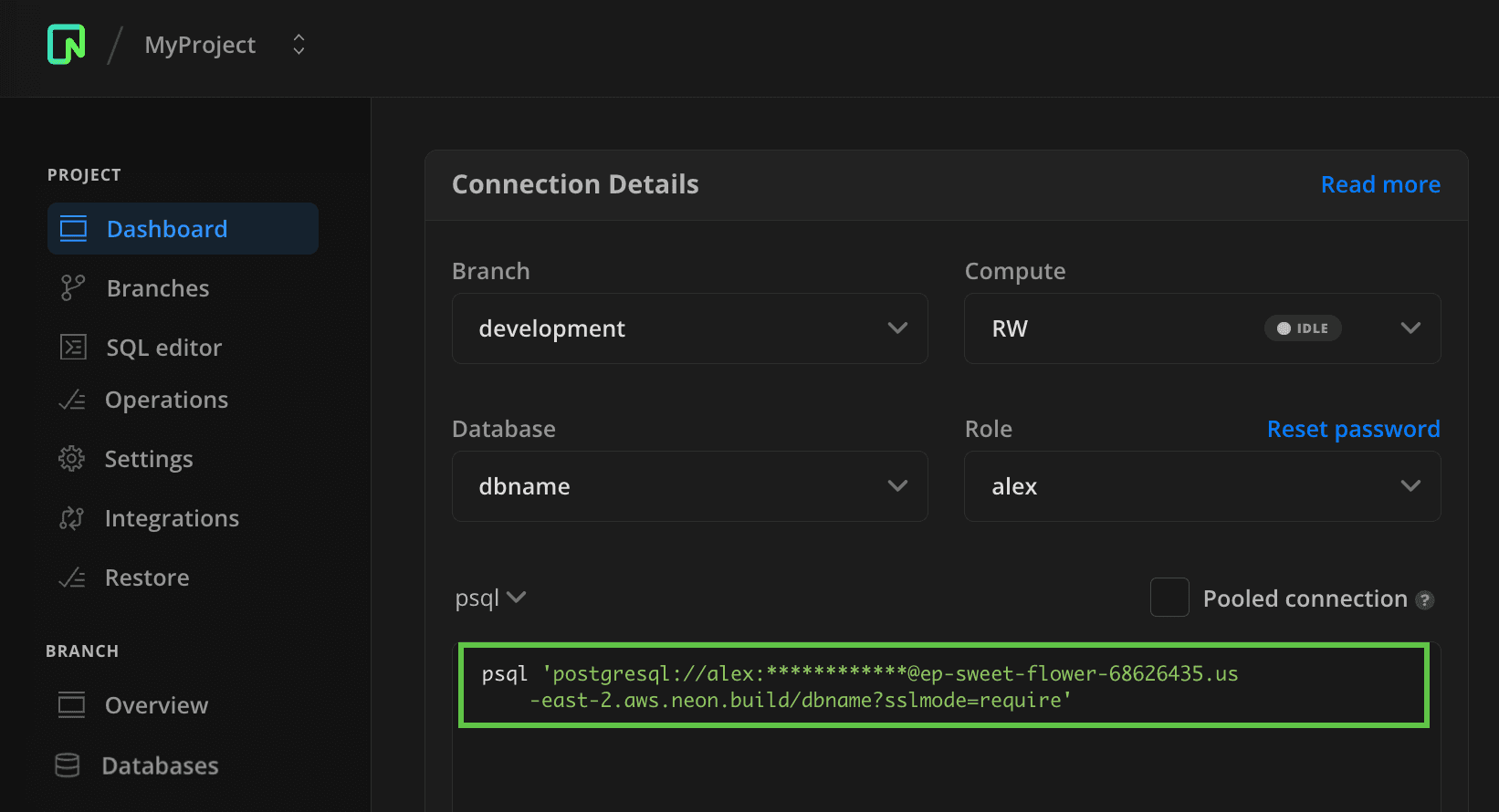Connect from TypeORM to Neon
Learn how to connect to Neon from TypeORM
TypeORM is an open-source ORM that lets you to manage and interact with your database. This guide covers the following topics:
Connect to Neon from TypeORM
To establish a basic connection from TypeORM to Neon, perform the following steps:
-
Retrieve your Neon connection string. In the Connection Details widget on the Neon Dashboard, select a branch, a user, and the database you want to connect to. A connection string is constructed for you.
 The connection string includes the user name, password, hostname, and database name.
The connection string includes the user name, password, hostname, and database name. -
Update the TypeORM's DataSource initialization in your application to the following:
import { DataSource } from 'typeorm'; export const AppDataSource = new DataSource({ type: 'postgres', url: process.env.DATABASE_URL, ssl: true, entities: [ /*list of entities*/ ], }); -
Add a
DATABASE_URLvariable to your.envfile and set it to the Neon connection string that you copied in the previous step. We also recommend adding?sslmode=requireto the end of the connection string to ensure a secure connection.Your setting will appear similar to the following:
DATABASE_URL="postgresql://[user]:[password]@[neon_hostname]/[dbname]?sslmode=require"
tip
TypeORM leverages a node-postgres Pool instance to connect to your Postgres database. Installing pg-native and setting the NODE_PG_FORCE_NATIVE environment variable to true switches the pg driver to pg-native, which, according to some users, produces noticeably faster response times.
Use connection pooling with TypeORM
Serverless functions can require a large number of database connections as demand increases. If you use serverless functions in your application, we recommend that you use a pooled Neon connection string, as shown:
# Pooled Neon connection string
DATABASE_URL="postgresql://alex:AbC123dEf@ep-cool-darkness-123456-pooler.us-east-2.aws.neon.tech/dbname?sslmode=require"A pooled Neon connection string adds -pooler to the endpoint ID, which tells Neon to use a pooled connection. You can add -pooler to your connection string manually or copy a pooled connection string from the Connection Details widget on the Neon Dashboard. Use the Pooled connection checkbox to add the -pooler suffix.
Connection timeouts
A connection timeout that occurs when connecting from TypeORM to Neon causes an error similar to the following:
Error: P1001: Can't reach database server at `ep-white-thunder-826300.us-east-2.aws.neon.tech`:`5432`
Please make sure your database server is running at `ep-white-thunder-826300.us-east-2.aws.neon.tech`:`5432`.This error most likely means that the TypeORM query timed out before the Neon compute was activated.
A Neon compute has two main states: Active and Idle. Active means that the compute is currently running. If there is no query activity for 5 minutes, Neon places a compute into an idle state by default.
When you connect to an idle compute from TypeORM, Neon automatically activates it. Activation typically happens within a few seconds but added latency can result in a connection timeout. To address this issue, you can adjust your Neon connection string by adding a connect_timeout parameter. This parameter defines the maximum number of seconds to wait for a new connection to be opened. The default value is 5 seconds. A higher setting may provide the time required to avoid connection timeouts. For example:
DATABASE_URL="postgresql://[user]:[password]@[neon_hostname]/[dbname]?sslmode=require&connect_timeout=10"note
A connect_timeout setting of 0 means no timeout.
Need help?
Join our Discord Server to ask questions or see what others are doing with Neon. Users on paid plans can open a support ticket from the console. For more detail, see Getting Support.